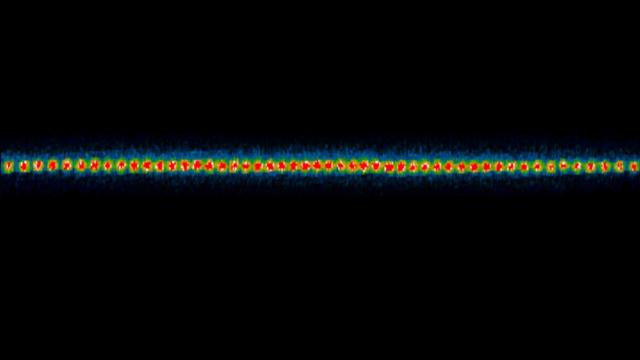A startup based in Maryland has released and tested an impressive new quantum computer that demonstrates the power of an occasionally overlooked quantum computing architecture.
Companies like IBM, Google, and Rigetti are developing new kinds of computer processors that rely on the mathematics of subatomic particles to potentially perform calculations difficult for classical computers to do. These devices use superconductors as the basis for their qubits. A company called IonQ, however, has now announced a state-of-the-art system that relies on the quantum nature of atoms themselves, and it’s one of the best-performing quantum computers yet.
How many qubits, or quantum bits, does it have? Well, these days, qubit count is a misleading number for understanding how powerful a quantum computer is. It’s more about how good those qubits are.
“If you look at raw gate count or qubit numbers or fidelity, it doesn’t tell the whole story,” said Christopher Monroe, IonQ’s co-founder and chief executive and a physics professor at the University of Maryland. “What we’re trying to push is on is the idea that having standard metrics,” like algorithm performance, is more useful for comparing quantum computers.
Quantum computers’ power comes from how they simplify problems into qubits, rather than the bits used in classical computing. Both qubits and bits are two-state systems, like switches that can be set to either “zero” or “one.” But during the calculation, qubits are both a little bit zero and a little bit one, and can entangle, taking on combined states so that one can’t be described without the other (think, for two qubits, they can be a little bit zero-zero, a little bit zero-one, a little bit one-zero, and a little bit one-one). Once the calculation completes, the qubits return zeroes and ones just like regular bits, but the maths that got them there might one day have powerful applications in machine learning, modelling molecules for drug development, or cybersecurity.
This is how quantum computers work in theory, but building a truly functional machine is a challenge because qubits quickly lose their quantum nature due to nudges from the external environment. The key to building such a device is finding a quantum system that can act as the qubit. IBM, Google, and Rigetti have all used the behaviour of electrons flowing through superconducting wire to create a two-state quantum system. Others, like IonQ, instead use atoms themselves, where each qubit is an individual atom held in place by lasers, the two qubit states are a pair of electron energy levels, and the qubits are controlled and measured with special laser pulses.
IonQ reports that its machine could be built as large as 160 qubits, though it has only performed computing operations, or “gates,” on 79 qubits. This doesn’t mean much. Instead, it’s important to note that its one- and two-qubit gate fidelities are 99.97 per cent and 99 per cent—this just means that if you try to perform a calculation on one or two qubits, the computer returns an expected result most of, but not all of, the time.
The researchers ran an algorithm that relied on 11 of the qubits, called the Bernstein-Vazirani algorithm, which returned the expected value 73 per cent of the time. A conventional computer simulating a quantum computer completed this algorithm just 0.2 per cent of the time—one lecture from University of Texas professor Scott Aaronson explained that this is an algorithm designed “around what a quantum computer would be able to do.”
Now, you probably want to know if this is “good.” In context, it’s very good, perhaps better than any quantum computer around, Sydney Schreppler, a postdoctoral fellow in physics at the University of California, Berkeley, told Gizmodo. “You can compare IonQ’s report of 11 fully connected qubits with >99 per cent two-qubit gate fidelity to average fidelities in the mid 80’s to mid 90’s for commercial superconducting chips with similar qubit numbers,” she said, citing a recent Quantum Computing Report post.
And unlike the competitors, IonQ’s qubits are fully connected; basically, in the algorithm, each one shakes hands with all of the others. “Members of the IonQ team like to point out that the enhanced connectivity of ion-based quantum computers lets them run quantum algorithms with fewer steps and better fidelity,” Schreppler said. “This probably contributes to the high observed success rate of the Bernstein-Vazirani algorithm here.”
This is still nowhere near the error-corrected computer of the future that would require millions of qubits instead of a dozen or dozens. But it’s a powerful contender in the new era of noisy but potentially useful intermediate-scale quantum computers. What they will be useful for, though, is unclear.
IonQ will continue developing its hardware and software, improving the laser controllers that allow its scientists to perform calculations on the device. Additionally, they plan to “invite leading players in government and industry to a private beta test of its systems,” according to a press release. Now, scientists have to figure out what to actually do with these things.
“The real problem in the field is that we don’t know the killer app of quantum computers yet,” said Monroe. “We have to build them and find out where they will resonate.”
